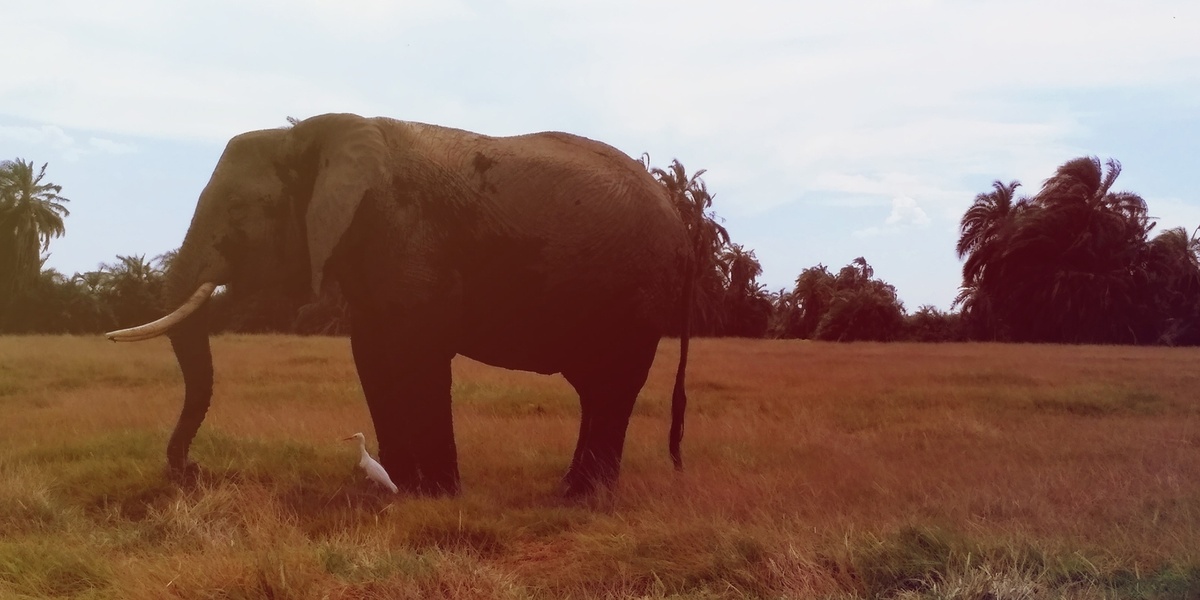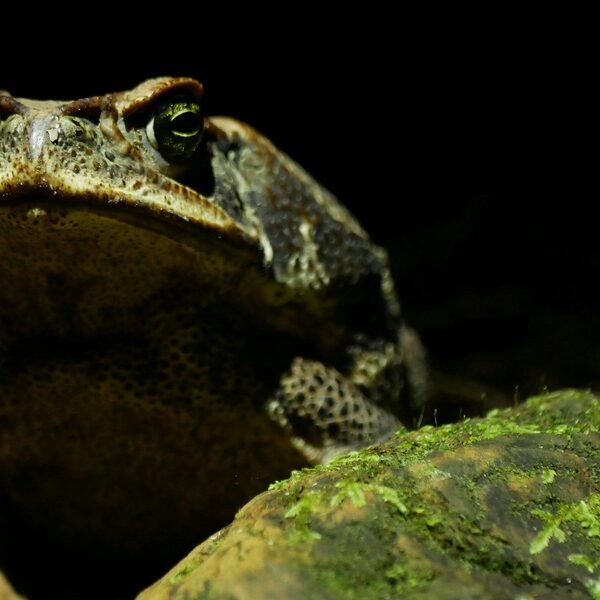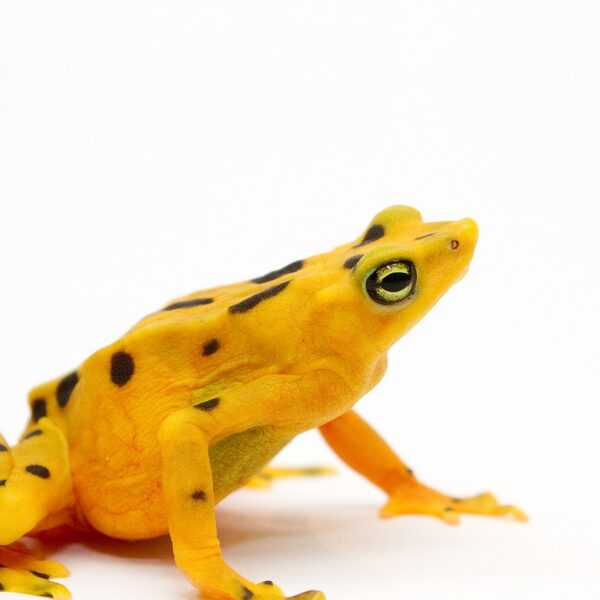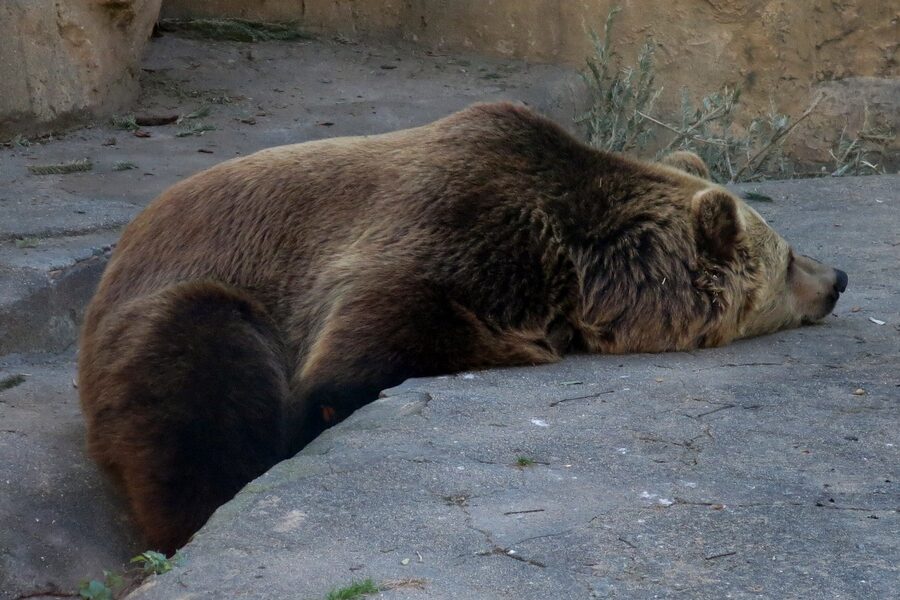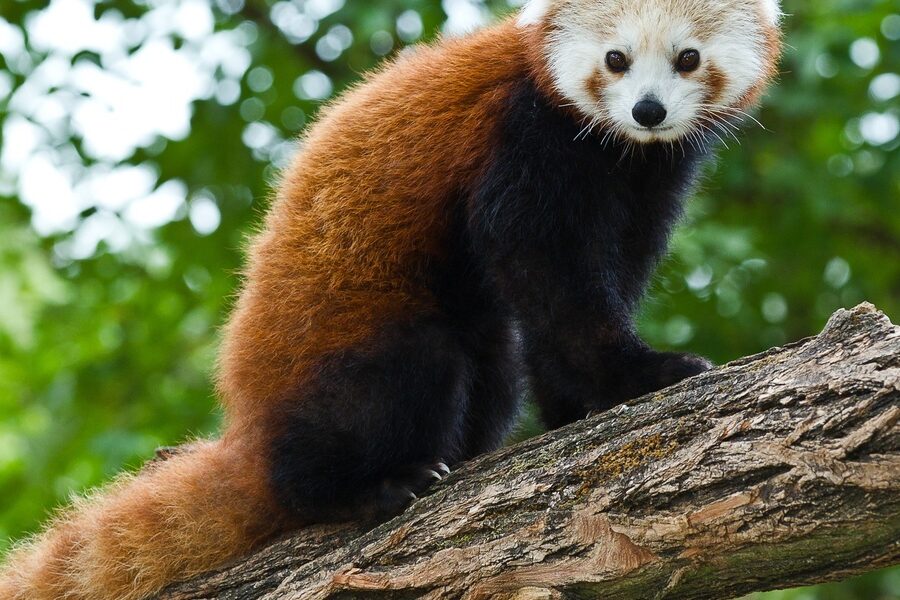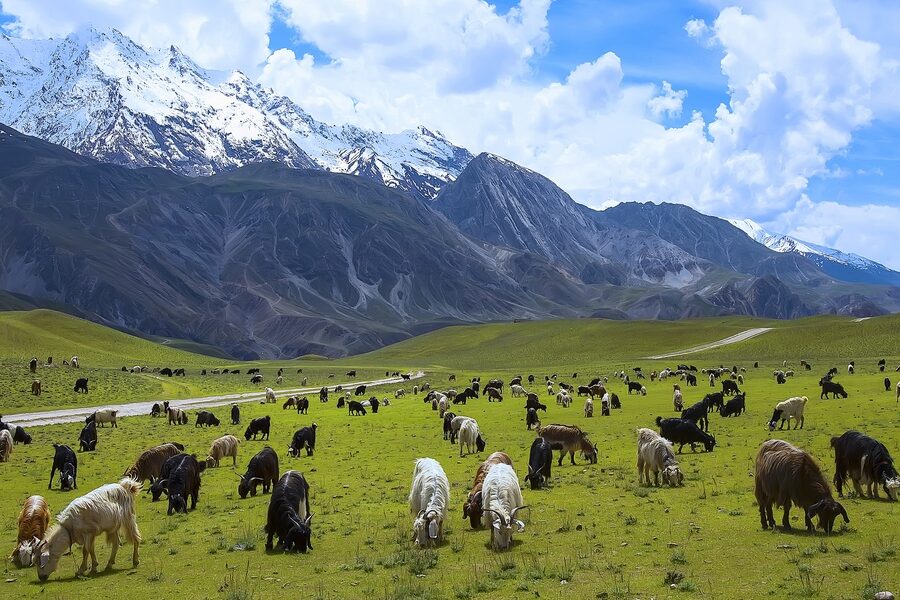The Okavango Delta is a living landscape of slow-moving channels, seasonal floodplains and islands that shift with every rise and fall of water. That dynamism creates a patchwork of marsh, woodland and grassland habitats where different species concentrate at different times of year.
There are 34 okavango delta animals, ranging from African Bullfrog to Wattled Crane. For each species you’ll find below Scientific name, Where/when to see and IUCN status to help with identification, timing and conservation context — you’ll find below.
What’s the best time to spot wildlife in the Okavango Delta?
The dry season (roughly May–October) tends to be best for large mammals because water concentrates animals and visibility is clearer; peak flood months (usually June–September) are ideal for waterbirds and lush waterways, while the rainy season brings breeding activity for frogs and other species—check the Where/when to see column for species-specific timing.
How can I use the Scientific name, Where/when to see and IUCN status when planning a visit?
Use the Scientific name to avoid confusion with regional common names, consult Where/when to see for habitat and seasonal tips, and check IUCN status to prioritize sightings of rarer species and to plan low-impact viewing; local guides and binoculars make following those columns much easier.
Okavango Delta Animals
| Common name | Scientific name | Where/when to see | IUCN status |
|---|---|---|---|
| African Elephant | Loxodonta africana | Woodlands and floodplains, especially during the dry season (May-Oct) around permanent water. | Endangered |
| Lion | Panthera leo | Savannas and open woodlands, often resting in shade during the day; active at dawn/dusk. | Vulnerable |
| Leopard | Panthera pardus | Riverine forests and dense woodlands; they are elusive and primarily nocturnal. | Vulnerable |
| African Wild Dog | Lycaon pictus | Open savannas and woodlands, constantly roaming large territories. | Endangered |
| Cheetah | Acinonyx jubatus | Open grasslands and savannas where they can utilize their speed. | Vulnerable |
| Spotted Hyena | Crocuta crocuta | Widespread in savannas and woodlands; most active at night. | Least Concern |
| Hippopotamus | Hippopotamus amphibius | Permanent rivers, channels, and lagoons throughout the Delta. | Vulnerable |
| Cape Buffalo | Syncerus caffer | Floodplains and savanna grasslands, always staying close to water. | Near Threatened |
| Southern Giraffe | Giraffa giraffa | Woodlands and savannas, browsing on acacia and other trees. | Least Concern |
| Plains Zebra | Equus quagga | Open grasslands and floodplains, often mixing with other herbivores. | Near Threatened |
| Red Lechwe | Kobus leche | Shallow floodplains and marshy areas; a signature Delta antelope. | Near Threatened |
| Sitatunga | Tragelaphus spekii | Deep in permanent swamps and papyrus reed beds; extremely elusive. | Least Concern |
| Impala | Aepyceros melampus | Woodlands and savanna edges; the most common antelope in the Delta. | Least Concern |
| Greater Kudu | Tragelaphus strepsiceros | Dense woodlands and thickets, where their coats provide camouflage. | Least Concern |
| Chacma Baboon | Papio ursinus | Widespread in woodlands and savannas, often near water sources. | Least Concern |
| Vervet Monkey | Chlorocebus pygerythrus | Riverine forests and woodlands, especially near lodges and camps. | Least Concern |
| Spotted-necked Otter | Hydrictis maculicollis | Clear, permanent waterways and deep lagoons. | Near Threatened |
| Warthog | Phacochoerus africanus | Open grasslands and woodlands throughout the Delta. | Least Concern |
| Nile Crocodile | Crocodylus niloticus | Rivers, channels, and lagoons; a key apex predator. | Least Concern |
| Nile Monitor | Varanus niloticus | Along riverbanks and in wetlands; often seen swimming. | Least Concern |
| African Fish Eagle | Haliaeetus vocifer | Along rivers, channels, and lagoons with prominent trees. | Least Concern |
| Pel’s Fishing Owl | Scotopelia peli | Dense riverine forests along permanent water channels; strictly nocturnal. | Least Concern |
| Slaty Egret | Egretta vinaceigula | Shallowly flooded plains and drying pools; a key Delta special. | Vulnerable |
| Wattled Crane | Bugeranus carunculatus | Open, shallow floodplains and grasslands. | Vulnerable |
| Saddle-billed Stork | Ephippiorhynchus senegalensis | Shallow wetlands and river edges; often seen in pairs. | Least Concern |
| African Skimmer | Rynchops flavirostris | Open water channels and sandbanks, especially during low water (Aug-Oct). | Endangered |
| Lilac-breasted Roller | Coracias caudatus | Open woodlands and savanna; very common and conspicuous. | Least Concern |
| Southern Carmine Bee-eater | Merops nubicoides | Nests in riverbank colonies (Aug-Nov); forages over floodplains. | Least Concern |
| Malachite Kingfisher | Corythornis cristatus | Reed beds and vegetated banks of slow-moving water. | Least Concern |
| Pied Kingfisher | Ceryle rudis | Open water of rivers, channels, and lagoons. | Least Concern |
| African Jacana | Actophilornis africanus | Wetlands with floating vegetation like water lilies. | Least Concern |
| Goliath Heron | Ardea goliath | Shallow water of lagoons and floodplains; generally solitary. | Least Concern |
| Tigerfish | Hydrocynus vittatus | Main river channels and deep, clear lagoons. | Least Concern |
| African Bullfrog | Pyxicephalus adspersus | Seasonal pans and flooded grasslands after heavy rains. | Least Concern |
Images and Descriptions
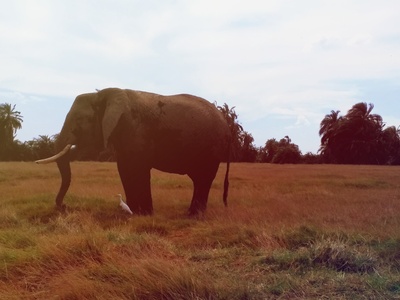
African Elephant
The world’s largest land animal, identified by its large ears, trunk, and tusks. They are highly intelligent, social animals that shape their environment, creating pathways and dispersing seeds. Spotting tip: Listen for their low rumbles and look for freshly broken branches.
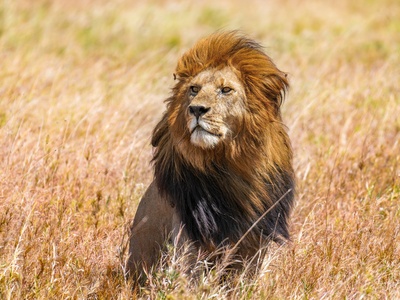
Lion
Africa’s largest cat, known for its powerful build and the male’s distinctive mane. Lions are the only truly social cats, living in prides. They are apex predators crucial for ecosystem balance. Spotting tip: Scan shady areas under trees and listen for roaring at night.
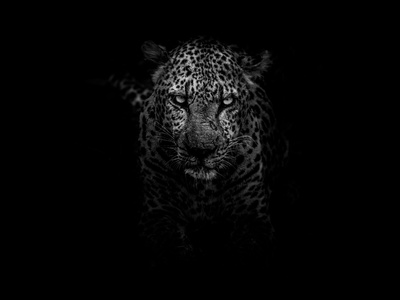
Leopard
A powerful, solitary cat with a distinctive rosette-patterned coat providing excellent camouflage. Leopards are famous for their strength, often hoisting kills into trees to protect them from scavengers. Spotting tip: Scan the branches of large sausage trees and leadwoods.
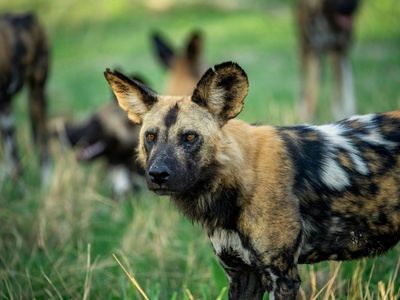
African Wild Dog
A highly social canid with unique, multi-colored coats of brown, black, and white. Known for their large, rounded ears and incredible hunting success rates, they are cooperative pack hunters. Spotting tip: Look for them on the move in the early morning or late afternoon.
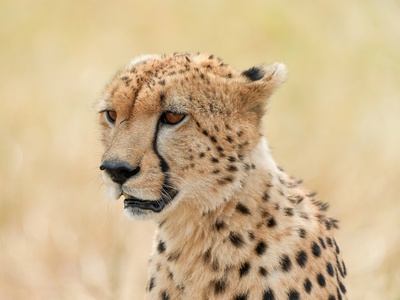
Cheetah
The world’s fastest land animal, recognized by its slender body, long legs, and distinctive black “tear marks” running from its eyes. Unlike other big cats, they hunt by day using explosive speed. Spotting tip: Scan open plains and the tops of termite mounds.
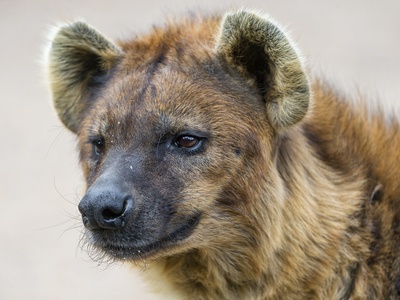
Spotted Hyena
A powerful and intelligent carnivore with a sloping back and a unique “laughing” call. Often misunderstood as mere scavengers, they are also highly efficient hunters with incredibly strong jaws. Spotting tip: Look for them near lion kills or listen for their whooping calls at night.
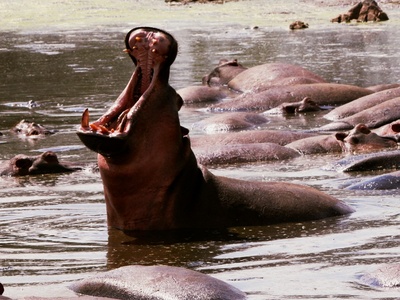
Hippopotamus
A large, semi-aquatic mammal that spends its days in water to keep cool and emerges at night to graze. Despite their placid appearance, hippos are highly territorial and one of Africa’s most dangerous animals. Spotting tip: Look for their eyes and ears poking above the water surface.
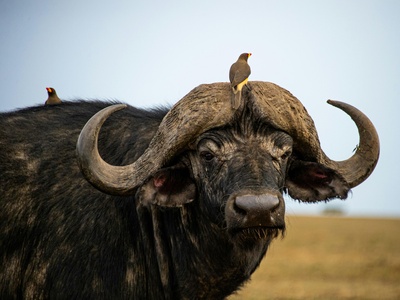
Cape Buffalo
A massive, formidable bovid with distinctive, fused horns that form a “boss” on its forehead. They live in large herds and are known for their protective, mobbing behavior against predators. Spotting tip: Look for large herds grazing on open floodplains, often accompanied by oxpeckers.
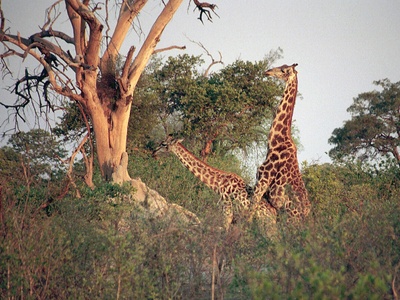
Southern Giraffe
The world’s tallest mammal, easily identified by its long neck and patchy coat. Their height gives them a unique feeding advantage and a great vantage point for spotting predators. Spotting tip: Scan the tree line for their distinctive silhouettes.
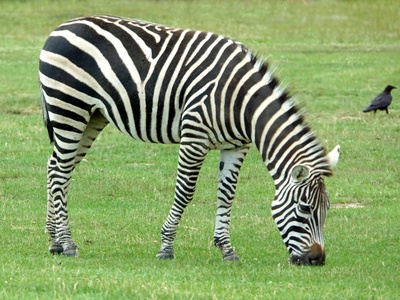
Plains Zebra
Unmistakable with its bold black and white striped coat, unique to each individual. Zebras are social animals living in family groups and are a primary prey species for many large predators. Spotting tip: Their stripes are most visible in open, sunlit areas.
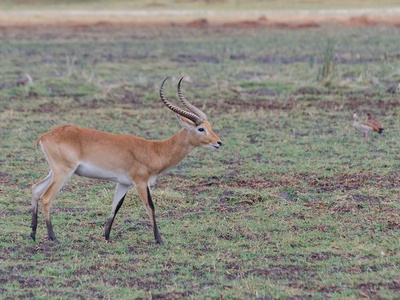
Red Lechwe
A medium-sized antelope with a shaggy, reddish-brown coat and elongated hooves adapted for wading. They are often seen spectacularly bounding through shallow water to escape danger. Spotting tip: Look for large herds in the shallow, inundated grasslands.
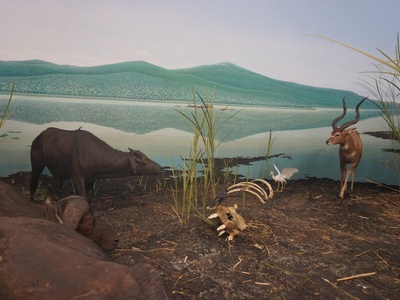
Sitatunga
A rare and semi-aquatic antelope with a shaggy, water-repellent coat and long, splayed hooves that allow it to walk on soft marshland. They are shy and will submerge themselves with only their nostrils showing. Spotting tip: Requires a mokoro trip deep into papyrus beds.
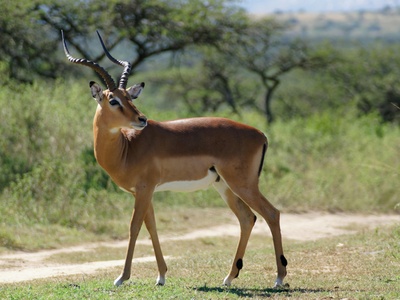
Impala
A graceful, medium-sized antelope with a reddish-brown coat and white underbelly. Males have lyre-shaped horns. They are known for their incredible leaping ability when alarmed. Spotting tip: Abundant everywhere, often seen in large breeding herds.
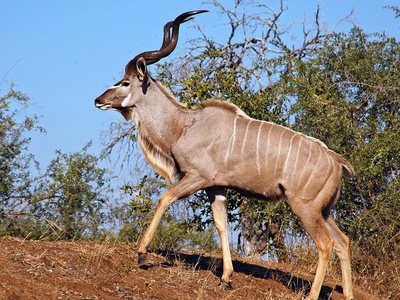
Greater Kudu
A large, elegant antelope with a greyish-brown coat marked with thin vertical white stripes. Males possess magnificent, long spiral horns. They are browsers and are typically shy and elusive. Spotting tip: Look for them in thick bush during the heat of the day.
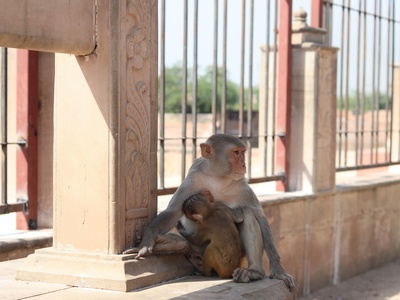
Chacma Baboon
A large monkey with a dog-like muzzle and a coat of greyish-brown fur. They are highly social, living in large troops with complex hierarchies, and are resourceful, omnivorous foragers. Spotting tip: Listen for their loud barking calls and look for troops foraging on the ground.
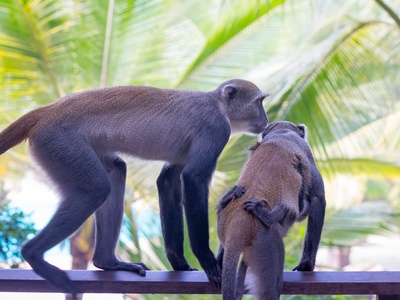
Vervet Monkey
A small, grey-haired monkey with a black face and a distinctive blue scrotum in adult males. They are highly adaptable and social, often seen foraging for fruits, seeds, and insects. Spotting tip: Common around camps, but be aware of their opportunistic nature.
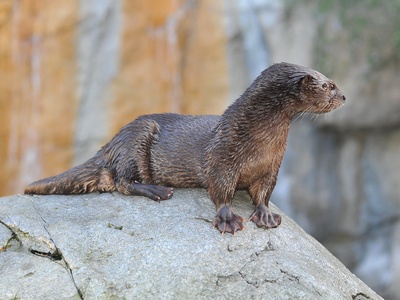
Spotted-necked Otter
A sleek, playful aquatic mammal with a dark brown coat and cream-colored spots on its throat. They are social, often seen in family groups, and are expert fishers. Spotting tip: Look for their heads bobbing in the water in quiet channels or lagoons.
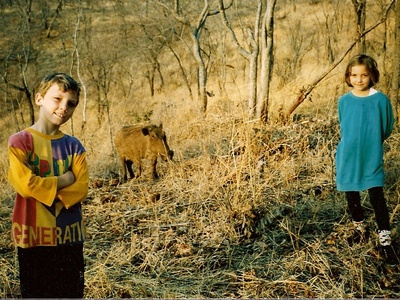
Warthog
A charismatic member of the pig family, identified by facial “warts” and upward-curving tusks. They are often seen kneeling on their front legs to graze and trot away with their tails held straight up. Spotting tip: Look in open clearings, especially in the morning.
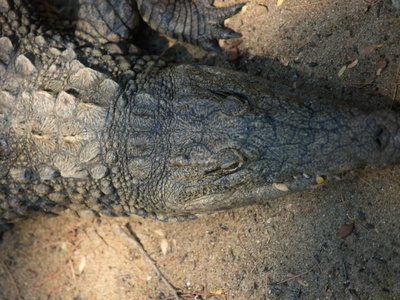
Nile Crocodile
Africa’s largest reptile, a formidable ambush predator that has remained unchanged for millions of years. They are often seen basking on sandbanks to regulate their body temperature. Spotting tip: Look for log-like shapes on riverbanks and in the water.
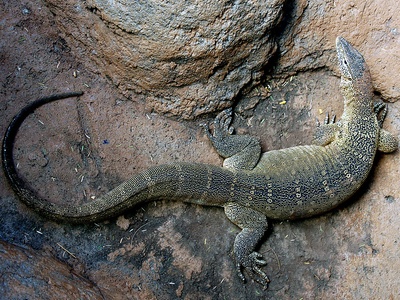
Nile Monitor
A very large lizard, growing up to 2 meters long, with a powerful tail and claws. They are active predators and scavengers, feeding on eggs, small animals, and carrion. Spotting tip: Look for them basking on logs or foraging along the water’s edge.
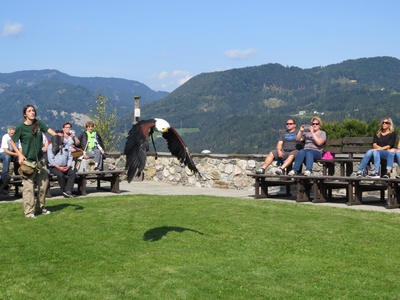
African Fish Eagle
A large, magnificent eagle with a pure white head and chest, and a chestnut belly. Its distinctive, ringing call is often called “the voice of Africa” and is a classic sound of the Delta. Spotting tip: Listen for its call and scan the tops of tall trees near water.
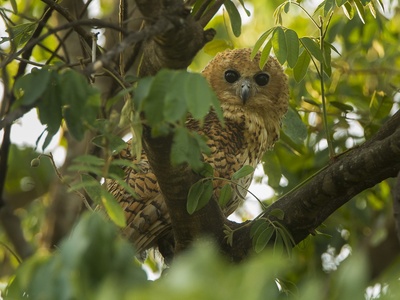
Pel’s Fishing Owl
A huge, reddish-brown owl that specializes in catching fish at night. It is one of the most sought-after birds for enthusiasts due to its rarity and elusive nature. Spotting tip: Requires a night drive and a very keen-eyed guide.
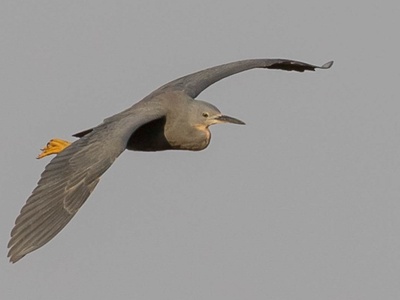
Slaty Egret
A medium-sized, dark grey heron with distinctive yellow legs and a wine-red throat. The Okavango is a global stronghold for this near-endemic and threatened species. Spotting tip: Look for it actively foraging in shallow, receding floodwaters.
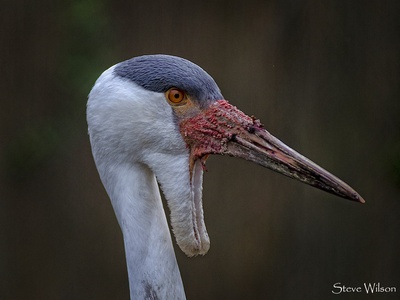
Wattled Crane
The largest and rarest of Africa’s cranes, recognized by its white neck and feathered “wattles” hanging from its chin. The Okavango is a critical breeding ground for this threatened species. Spotting tip: Look for pairs in open wetlands.
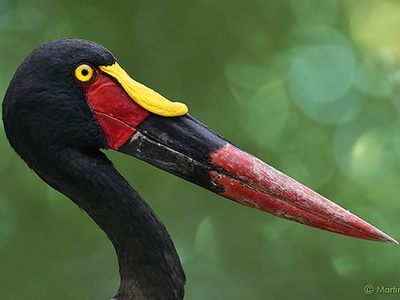
Saddle-billed Stork
A huge, strikingly colored black-and-white stork with a massive red and black bill topped by a yellow “saddle”. They are solitary or paired birds that hunt for fish in shallow water. Spotting tip: Their impressive size makes them easy to spot in open marshes.
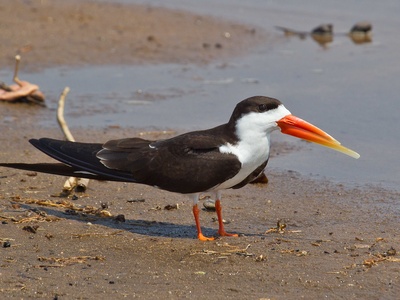
African Skimmer
A unique black-and-white bird with a bright orange bill where the lower mandible is longer than the upper. They fly low over the water, “skimming” the surface to catch small fish. Spotting tip: Look for them flying low over calm water in the late afternoon.
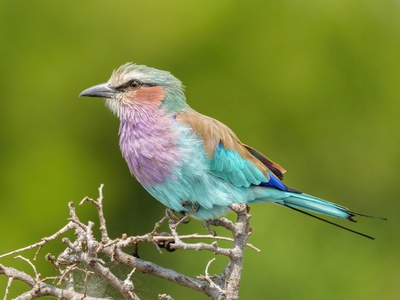
Lilac-breasted Roller
An impossibly colorful bird with a lilac throat, blue belly, and green head. They are often seen perched on exposed branches, from which they hawk for insects and other small prey. Spotting tip: Their bright colors make them unmissable on roadside shrubs.
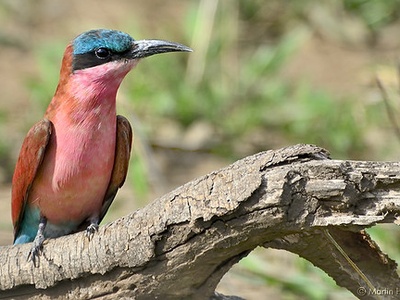
Southern Carmine Bee-eater
A stunningly vibrant pinkish-red bird with a blue crown. These seasonal migrants arrive in vast numbers to breed, creating spectacular colonies by digging nests into vertical sandbanks. Spotting tip: Look for large nesting colonies along dry riverbanks in spring.
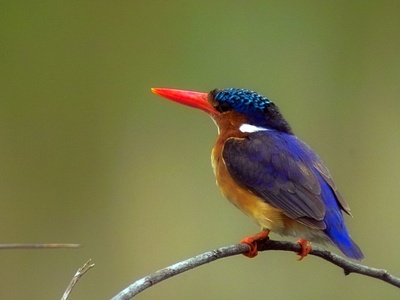
Malachite Kingfisher
A tiny, jewel-like bird with iridescent blue upperparts, a rufous belly, and a bright red bill. It dives from a low perch to catch tiny fish and aquatic insects. Spotting tip: Look for a flash of blue on reeds overhanging quiet water channels.
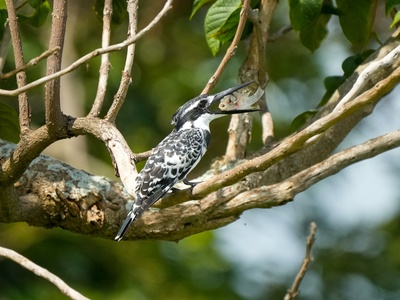
Pied Kingfisher
A conspicuous black-and-white kingfisher famous for its ability to hover over water before diving for fish. They are often seen in pairs or small family groups and are very vocal. Spotting tip: Look for them hovering purposefully over any open water body.
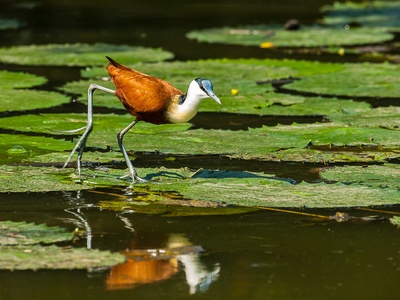
African Jacana
A unique wading bird nicknamed the “Jesus bird” for its apparent ability to walk on water. Its incredibly long toes and claws distribute its weight, allowing it to move across floating plants. Spotting tip: Look carefully on lily pads in calm lagoons.
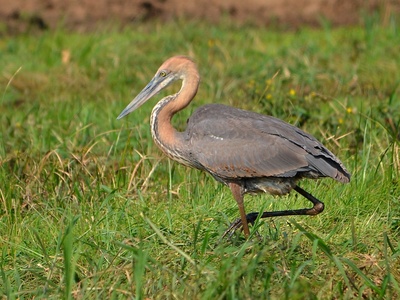
Goliath Heron
The world’s largest heron, standing up to 1.5 meters tall. It has a slaty grey body and a chestnut head and neck. It is a patient hunter, waiting motionless for large fish to approach. Spotting tip: Its immense size makes it stand out, even from a distance.
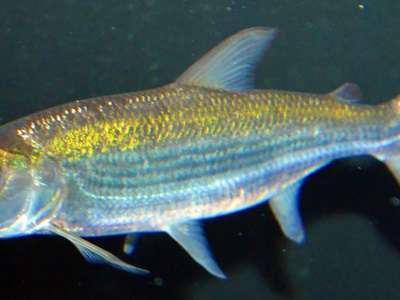
Tigerfish
The Delta’s most famous fish, a ferocious freshwater predator with formidable, interlocking teeth. It is a prized target for sport fishermen and known for its powerful, acrobatic fighting. Spotting tip: Can be seen creating splashes when hunting smaller fish near the surface.
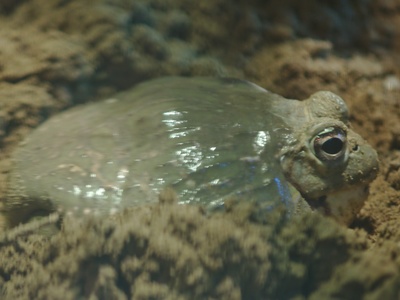
African Bullfrog
One of the world’s largest frogs, with males being highly aggressive and protective of their tadpoles. They spend most of the year dormant underground, emerging to breed in explosive, short-lived events. Spotting tip: Listen for deep croaking after the first major summer rains.
